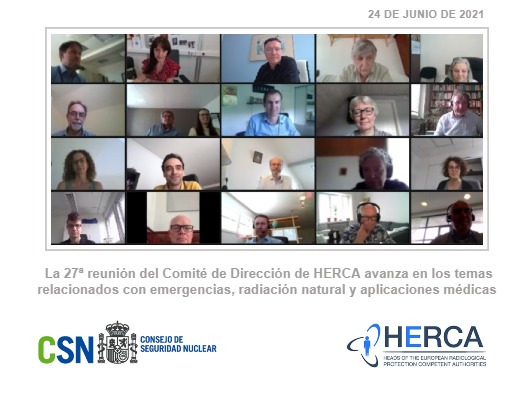Contenido principal
2021
The 27th meeting of the HERCA Steering Committee advances in issues related to emergencies, natural radiation and medical applications

A delegation from the Spanish Nuclear Safety Council (CSN) led by its commissioner, Pilar Lucio, and the deputy director of Operational Radiological Protection, Javier Zarzuela, has participated in the twenty-seventh meeting of the of the steering committee of HERCA (Heads of the European Radiological Protection Competent Authorities) held online on the 23d and 24th of June.
The president of HERCA, Karla Petrová, has started the meeting by sharing with the attendees the main activities of representation of the association in the last semester. Among these activities, it is worth highlighting the meeting held with WENRA (Western European Nuclear Regulators Association) aiming to maintain and foster relations around issues of common interest to both organizations and, in particular, to highlight the importance of the HERCA -WENRA approach, whose objective is to improve cross-border coordination to apply protective actions during the initial phases in the event of an accident. At this point, the commissioner Pilar Lucio stressed out the need to continue maintaining this joint collaboration that can allow, among other things, to improve the interfaces in the preparation of on-site and off-site emergency plans in terms of recommendations and requirements.
In addition, the activities carried out by the different working groups have been reviewed, as usual. It is worth noting the progress regarding the final report on the awareness campaign on medical exposures of the working group on medical applications, which has been very well received throughout Europe, and the proposal to suspend the working group on protontherapy for a few years, until the development of new technologies, makes necessary its reactivation to review the practical document on protontherapy approved last year. This document has been a great milestone within HERCA, since it compiles the knowledge and lessons learned from regulators in the licensing of this type of facilities. In this regard, the CSN has been a very relevant actor in the preparation of this document.
Meanwhile, the group on natural radiation has raised to the Committee the possibility of collaboration with the new European project EU-RAP on action plans against radon. This project aims to review and evaluate the established national action plans against radon or that are under development in the EU Member States in accordance with the requirements of the Council Directive 2013/59 / Euratom. The project will help the European Commission to assess compliance with the practical implementation of the radon action plans against these requirements. Among the most notable milestones of this group are the progress in the development of guidelines for the implementation of criteria for the exemption and clearance of NORM materials, in accordance with the aforementioned 2013/59 Directive.
During these working sessions, the presentation that the working group on sources and practices in research and industry has performed on the use of alternative technologies to reduce the risk due to the use of high-activity sealed sources has stood out, as well as the guide for the implementation of the regulation related to the installation, maintenance and services (IMS) of radiation sources, X-ray devices and other devices that emit ionizing radiation.
Finally, it was recalled that in December 2021 both the mandate of the presidency of Karla Petrová and that of the two vice-presidencies will end, among which is the director of radiological protection of the CSN, María Fernanda Sánchez Ojanguren.
HERCA is composed of representatives of 56 European authorities competent in Radiological Protection, belonging to 32 European countries. Since its creation in 2007, HERCA contributes to the harmonization of regulatory practices, the identification of common problems and the proposal of practical solutions to such problems, in the field of Radiological Protection.
* Check here the glossary of technical terms *
